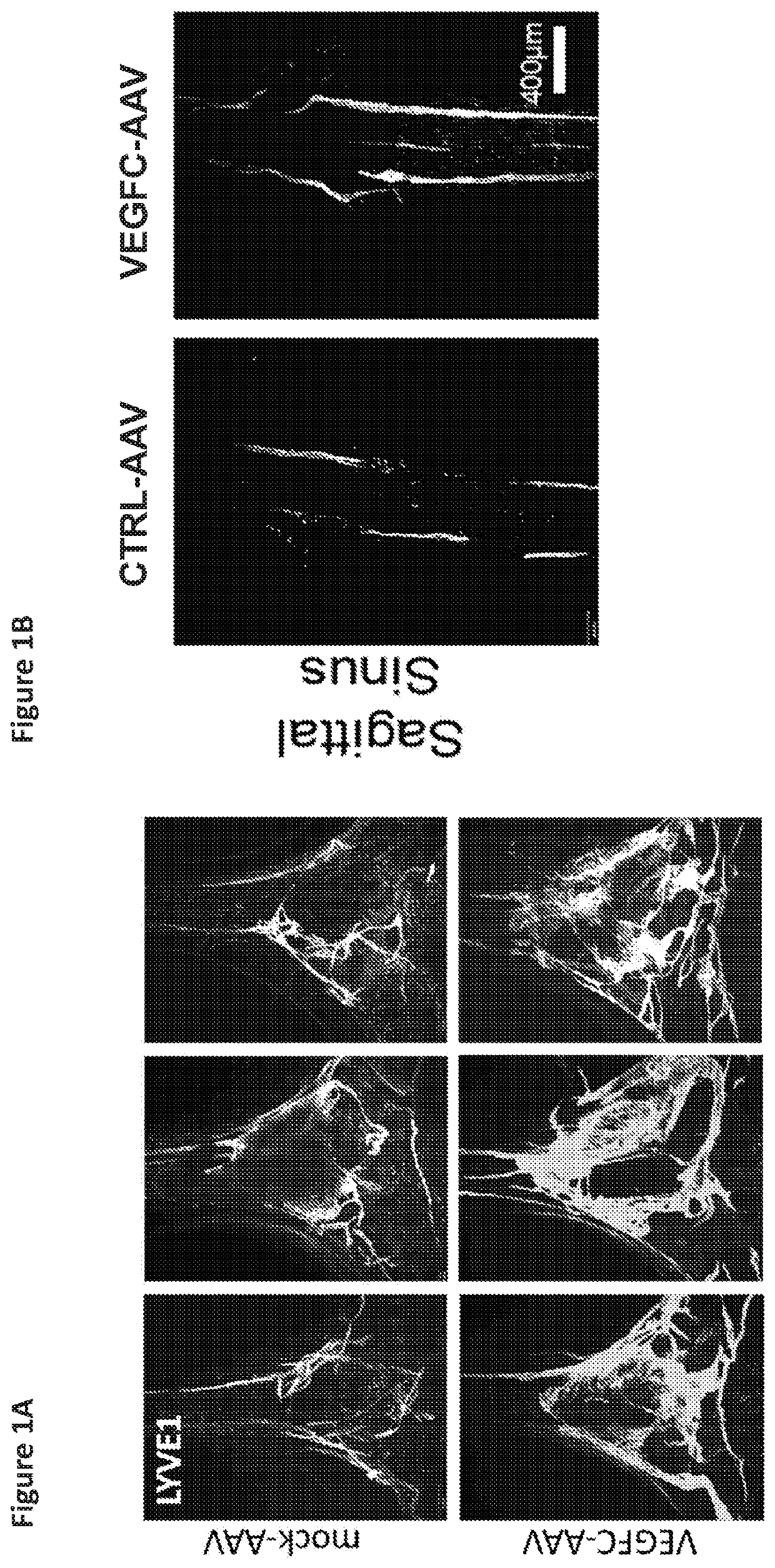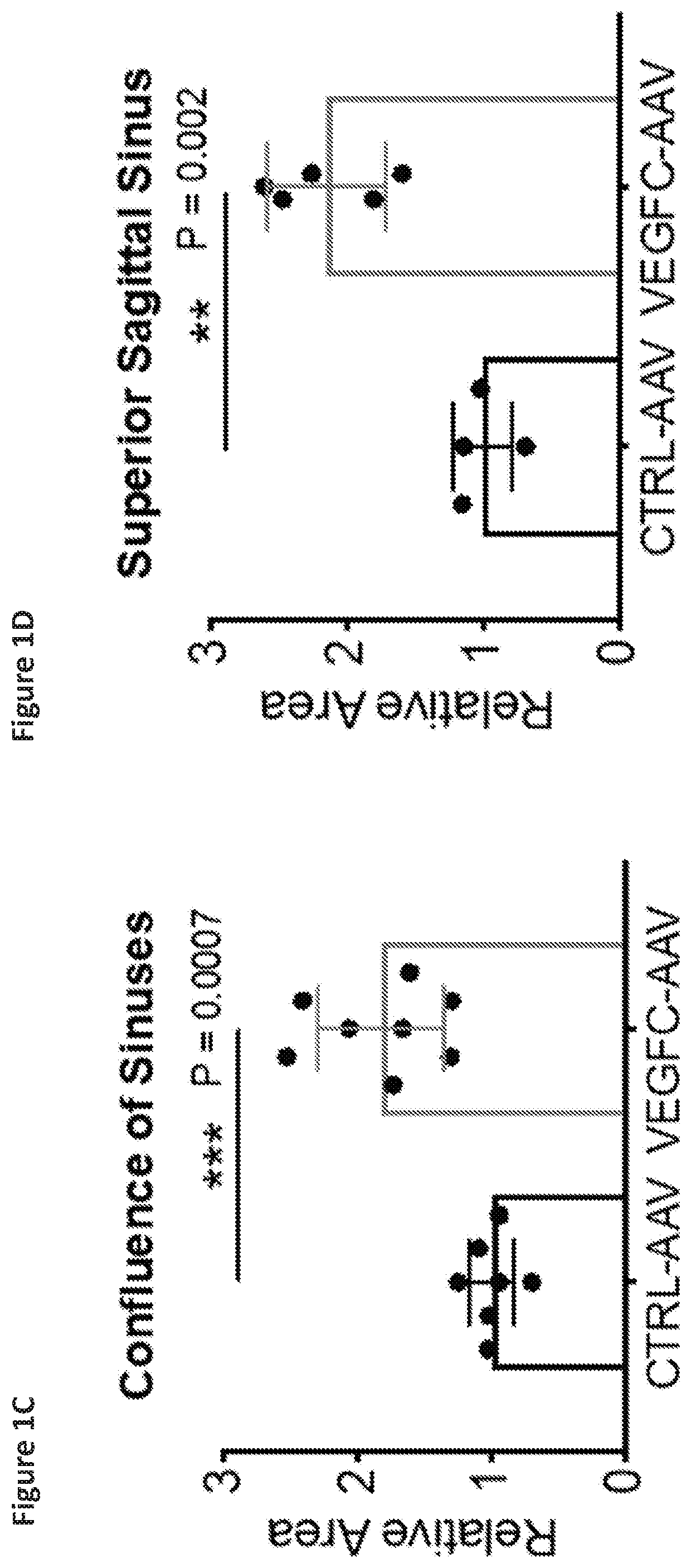Manipulation of meningeal lymphatic vasculature for brain and CNS tumor therapy
a meningeal lymphatic vasculature and brain tumor technology, applied in the direction of angiogenin, drug composition, immunological disorders, etc., can solve the problems of lack of t cell response in the cns, limited standard treatment, mixed efficacy of brain tumor therapy, etc., to induce lymphangiogenesis and reduce tumor volume.
- Summary
- Abstract
- Description
- Claims
- Application Information
AI Technical Summary
Benefits of technology
Problems solved by technology
Method used
Image
Examples
example 1
Assay of Inducement of Lymphatic Vasculature Proliferation in the Dural Lymphatics by VEGF-C
[0133]In order to address how immune surveillance affects tumor growth, the inventors used a model to examine tumor growth in the presence of increased meningeal lymphatics.
[0134]GL261, a C57BL / 6 syngeneic GBM cell line, was transduced to express the luciferase gene (GL261-Luc) [58]. GL261 parental cells were obtained from the NIH cancer cell repository. GL261-Luciferase cells were obtained from Yale University. GL261 and GL261-Luc cells were cultured in RPMI (10% FBS, 1% penicillin / streptomycin).
[0135]Wild type C57BL / 6 mice bred in house aged 8 weeks were used for all the experiments. The C57BL / 6 mice were purchased from the National Cancer Institute and Jackson Laboratory and subsequently bred and housed at Yale University. All procedures were performed in accordance to animal protocols. For tumor inoculation, animals were anaesthetized using a mixture of ketamine (50 mg kg−1) and xylazine ...
example 2
Assay of Inducement of Lymphatic Vasculature Proliferation in the Dural Lymphatics by VEGF-C
[0142]Manipulation of lymphatic vasculature can affect macromolecule clearance from the brain parenchyma [34-36, 50].
[0143]Mice were treated with VEGFC-AAV or mock-AAV as described in Example 1. A third group of wild type mice were treated only with PBS. Two months elapsed.
[0144]Syngeneic mouse GBM cells (GL261-Luc) were implanted into the striatum of mice that previously received either AAV coding for VEGF-C, a scrambled sequence (mock-AAV), or PBS (WT) two months prior. Specifically, 5,000 or 50,000 GL261-Luc cells were implanted intra-cranially into the striatum (coordinates 3 mm lateral and 1 mm posterior from bregma). The mice were observed for significant weight loss, signs of lethargy, back hunch or periorbital bleeding for survival end-points. All brains were collected after death or end-points to confirm tumor growth. Mice that did not die after 100 days were injected with 500,000 GL...
example 3
VEGFC-mRNA Production and Validation
[0151]VEGFC-mRNA was custom ordered from TriLink Biotechnologies with the sequence shown in FIG. 12. The mRNA was made with the TriLink Biotechnologies Cap1, and had complete 5-methyl cytosine and pseudo-uridine substitutions for stability. Specifically, 5-methyl cytosine increased stability and decreases deamination, while pseudo-uridine substitutions decreased nuclease activity, decreased innate recognition and could increase translation. Cap 1 does not active PR receptors. The mRNA was also polyadenylated (120A).
[0152]2 μg of VEGFC-mRNA was transfected into HEK293T cells using lipofectamine. HEK293T cells were purchased from ATCC. HEK293T cells were cultured in complete DMEM (4.5 g / L glucose, 10% FBS, 1% penicillin / streptomycin). Cy5-GFP mRNA was used as a control. Cell lysate was collected 6 hours and 24 hours after transfection. Samples were lysed in RIPA buffer and boiled for 5 minutes with sample buffer. Media was collected 24 hours after t...
PUM
| Property | Measurement | Unit |
|---|---|---|
| temperature | aaaaa | aaaaa |
| depth | aaaaa | aaaaa |
| stability | aaaaa | aaaaa |
Abstract
Description
Claims
Application Information
 Login to View More
Login to View More - R&D
- Intellectual Property
- Life Sciences
- Materials
- Tech Scout
- Unparalleled Data Quality
- Higher Quality Content
- 60% Fewer Hallucinations
Browse by: Latest US Patents, China's latest patents, Technical Efficacy Thesaurus, Application Domain, Technology Topic, Popular Technical Reports.
© 2025 PatSnap. All rights reserved.Legal|Privacy policy|Modern Slavery Act Transparency Statement|Sitemap|About US| Contact US: help@patsnap.com



